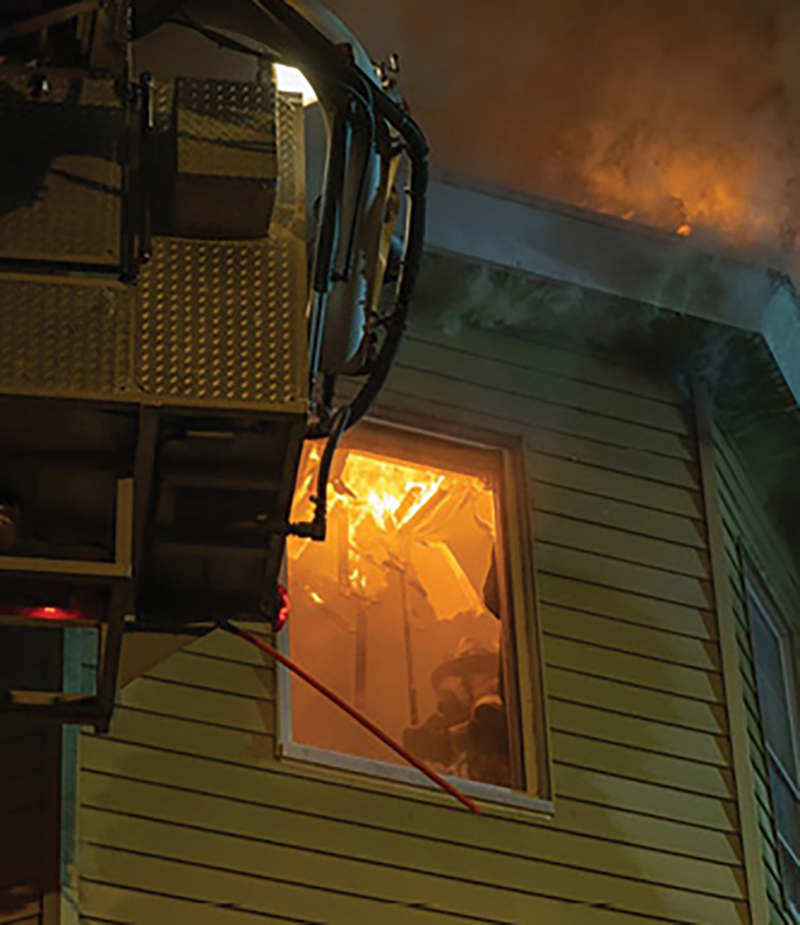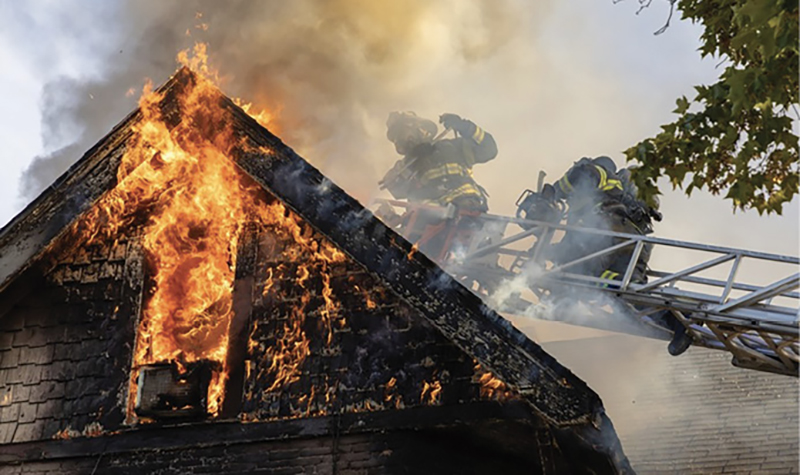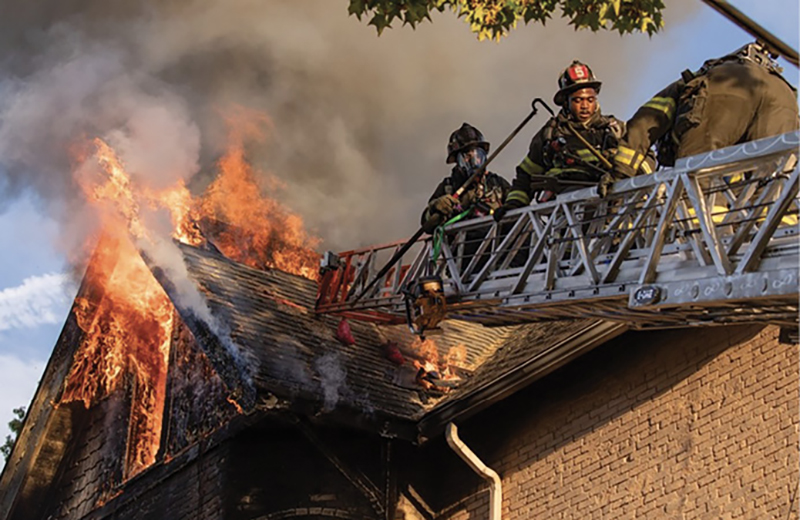By Nicholas Papa
When conducting ventilation operations, we must ensure that we outmaneuver the fire, not each other. Understanding the impact and limitations of our ventilation tactics and acknowledging we cannot practically “outvent” today’s fuel-rich fires are paramount. For ventilation to achieve its intended effect, the openings created must be accompanied by the swift and deliberate application of water to suppress the fire or the use of door control to manage the flow of air.
- Leveraging Fire Streams and Ventilation
- Overhaul Is Ventilation: Providing Air to Concealed Spaces
- Venting for Extinguishment at Peaked-Roof Dwellings
With the evolution of our working environment, increasing the fuel load and the responsiveness of the fire to any increase of oxygen, a narrow window of opportunity remains when the tactic is executed prior to the onset of suppression. To avoid conditions from inadvertently deteriorating, ventilation must be implemented in conjunction with the advancement of the nozzle team, unless the vented area can be isolated from the fire. If an opening needs to be made to best effect a rescue, despite the ability for these precautions to be taken, however, it should only be done with the clear understanding that it carries the inherent risk of rapidly drawing the fire to that location. Successfully navigating these dynamic factors and variables requires the establishment of organizational doctrine, training, and accountability at all levels.1 Your department must have appropriate standard operating procedures and unit/riding assignments; personnel who maintain the requisite knowledge, skills, and abilities; and positional discipline to execute accordingly.

1. Having standing orders that detail roles and responsibilities allows crews to go right to work on arrival, streamlining operations and facilitating coordination. (Photos by Pat Dooley.)
To coordinate ventilation with the extinguishment effort, the nozzle team must be, at least, moving in on the fire with a charged handline and be capable of advancing to the seat, as venting before suppression is initiated can lead to undue fire growth and spread if left unchecked. While preemptively sequencing ventilation as the fire attack is about to commence can initially result in an increase of flame production and higher temperatures at the ceiling level, as the environment leans out and the fire burns more efficiently, the exhausting of the fire’s by-products and the enhanced intake of fresh air can create a lifting effect and improve visibility and tenability at the floor level along the intake pathway. While this can yield the best possible outcome for the nozzle team on the approach and, most significantly, for any trapped occupants within that area, when immediately followed up by an effectively flowing and moving hose stream, the line between ventilation being prompt and premature can be fine and unforgiving, requiring a system to serve as a framework for decision making.
“Maneuver Firefighting”
A parallel can be drawn between the U.S. Marine Corps’ maneuver warfare doctrine, which spawned from U.S. Air Force Colonel John Boyd’s body of work, and the fire service. The philosophy is based on the concept that defeating an opponent is far more than wielding superior assets or power, winning simply through brute strength or attrition. The maneuver strategy, which directly correlates to the fireground (especially for agencies with substandard resources), is the deliberate application of force, applied in the most impactful and economical manner, leveraging strength against weakness and seizing opportunities to alter the situation and gain advantage.2,3 Its implementation relies on the following organizational and operational principles:2,4,5
- Decentralized command and flexible tactics (within the commander’s intent).
- Harmonious initiative, boldness, and force of will.
- Foresight and opportunism (through lateral coordination).
- Mutual trust and empowerment.
- Fluidity of thought and action.
- Intuitive decision making (based on tacit knowledge).
- Dispersion and concentration on the main effort (i.e., fire attack and search).
- Resilience to friction and contingency preparedness.
Essential to outmaneuvering the enemy (the fire) is the central tenet of tempo, which is defined as “the rate of activity relative to that of an adversary or a problem set.”2 Rate represents not only the speed but also the timing of action, which are complementary and interdependent for a successful reaction. Accurately assessing the fire’s rate of development is imperative to establishing the correct operational tempo. The purpose of our tactics is to positively influence the fire (and the environment)—“making it behave”—so we can gain the upper hand. Tempo, as it relates to the fireground, is more functionally defined as, “A series of disciplined, appropriate, and timely tactical actions that promote mission accomplishment and enhance survivability, which are performed at a rate quicker than the environment’s (fire’s) rate of change.”6 Achieving and maintaining an advantageous tempo require the ability to rapidly extract and process information from all forms. The more we understand about the fireground and firefighting tactics, particularly as they pertain to the built environment and the agency in which we work, the better we will be able to size up an incident and the more developed and reliable our intuition will be, allowing us to more consistently and rapidly make better decisions.

2. The ladder company inside team works to open up the ceilings to expose the fire in the cockloft for the engine company, while the ladder company outside team provides ventilation.
3. The ladder company outside team positions to vent the roof to provide the additional opening needed to relieve conditions below.

The ability to establish tempo (i.e., set a dominant pace of operation) is often determined by one’s level of situational awareness and naturalistic decision-making ability—recognizing cues and trends to address any threats and capitalize on emerging opportunities.7,8 Intuition is the capacity to readily match these patterns to past events or previous knowledge stored in our memory. While this is largely developed through personal experience, it can be honed through realistic/practical training and real-world reinforcement as well as vicariously through the experiences of others, with quality repetition and vivid imagery as the common denominators of its effectiveness. Performance, therefore, is a matter of our individual preparedness and our mindset—remaining mission-oriented and being what Fire Department of New York Lieutenant Pete Lund called “combat ready.”1 Those operating at a high level can anticipate the progression and determine the needs of a situation subconsciously. Because of this rapid cognition, these top performers can seemingly bypass those intermediate steps after briefly reading the conditions and devise an appropriate “action script,” immediately executing the tactics to accomplish the objective.7
Speed is one of the primary drivers of establishing a commanding tempo and is critical to gaining what U.S. Navy Admiral William McRaven refers to as “relative superiority,” which is defined as “decisive advantage over a larger or well-defended enemy.”9 Gaining advantage is more than just speed alone; it requires careful timing to engage at the pivotal moment. “Timing means knowing when to act and, equally important, when not to act.”10 When it comes to the matter of ventilation, no truer statement could be made. Developing a sense for the rate at which the conditions are changing, along with maintaining a keen awareness of the progress of the interior crews, is essential to our success.

4. Conditions on the top floor lift after the hole in the roof is completed, allowing the fire and its by-products to be directed up and out.
The Ventilation Rule of 3s
The great Renaissance man Leonardo Da Vinci once said, “Simplicity is the ultimate sophistication.” Distilling down the highly complex tactic of ventilation into its most organic form, focusing on the core components and the constants, is how we develop the systematic approach to practically and consistently put it into practice. Doing so also deepens the level and clarity of understanding as well as expedites the decision-making process, particularly under the uncertainty, friction, and time-compressed nature of the fireground. Devising a process in this algorithmic fashion ensures not only that the appropriate interventions are rapidly identified but also that they are implemented at the decisive moment.
When it comes to the tactic of ventilation, there are three fundamental elements of its execution: location (the “where”); amount; and, most significantly, timing (the “when”). After arriving on the scene of a working fire and sizing up the fireground, we must identify the ventilation objectives—supporting extinguishment, search, and access—to establish its purpose (the “why”) as well as to account for the aforementioned elements and, ultimately, to select the most appropriate means (the “how”) for achieving the desired end state. Yet still, the timing aspect of the operation can remain a sticking point. To overcome any hesitation or confusion, answering the following three questions (as they pertain to the function and intent of the opening) can provide the needed clarity:
- Is the nozzle team moving in on the fire with a charged handline and capable of effectively flowing and advancing to the seat?
- Is the area being vented isolated from the fire or capable of being isolated promptly after the opening is made?
- Is the opening being created to effect the rescue of a known victim?
If the answer to any of those questions is “yes,” then you can carry out the ventilation operation with relative confidence, being ever mindful of positioning (the location of the operation in relation to the fire and its direction of travel) and tempo (the reflex time of the operation compared to the fire’s severity/rate of change and the progress of suppression). There are, however, three limiting factors—wind, exposures, and terrain (i.e., the path to the seat of the fire)—which can require those actions to be altered.
On being recognized as a potential threat, there is one additional follow-up question that serves as a distinct caveat: Will the environment hinder the advancement of the nozzle team or the search team, or will the fire conditions adversely affect the operations, exposures, or any victims after the opening is created? As an additional layer of accountability, the final authorization to vent should come from the incident commander whenever you encounter the following conditions: wind, hoarding, and deep-seated/below-grade fires.
If the answer to that question is also “yes,” the location and timing of the ventilation operations must account for those issues. The creation of the openings will likely have to be delayed until the nozzle team is able to get water on the seat of the fire or even until the fire is knocked down altogether. Wind can be the most problematic, as it can dramatically alter the behavior of the fire, necessitating the most conservative posture to ensure the ventilation does not result in any further deterioration of the conditions and compromise our operations.
In any case, it is imperative the ventilation actions taken are in accordance with the three principles of coordination: communication (with the officer in charge of the fire floor and the incident commander), control (of the openings within the building and the resources deployed), and competence (in the mental, physical, and tactical domains).6 There are also three practices that should be integrated to protect the firefighters performing the ventilation functions and improve their likelihood of success as well as the incident as a whole:
- Maintain your egress and establish a secondary means.
- Keep the wind at your back.
- Sound/probe your travel path.
Serving as an operational baseline, the following statement provides the overarching parameters for conducting ventilation:
Do not create an uncontrollable opening until the nozzle team is ready to initiate suppression, the vented area is or can be immediately isolated from the fire, or the opening is being created to effect a rescue.
Using these guidelines will increase the likelihood of the openings created having their intended effect on the operations they aim to support as well as the ultimate goal of enhancing victim survivability. By facilitating the primary tasks of fire attack and search, the overall strategic mission of preserving life and property can be better accomplished.
Outliers
Overcoming novelty and adversity is a matter of acclimating to the unfamiliar circumstance you find yourself in—“connecting the dots.” Sensemaking is the ability to sift through the barrage of sensory inputs and dial in on the ones that truly matter. “Once the ‘non-dots’ are removed, the task of connecting the remaining dots is much easier.”11 It is not the volume of information that makes the difference; it is the relevancy. Decision making is all about establishing the meaning and translating it into an effective action plan. What we take in through our continuous size-up process must be accurately and rapidly interpreted for it to become purposeful—the difference between mere information and actual intelligence.
The greater our understanding of the environment in which we operate and the interrelation with our tactics and victim survivability, the greater our capacity will be to forecast what is to come and identify the appropriate interventions. Through the use of routines and simple mental models, we can establish a baseline of expectations, serving as “anchors,” and more readily detect and proactively account for any anomalies, especially those that may compromise our operations. These heuristics are simply a guide, however, and require critical thought to establish the context and relevance to each incident. We must be cautious not to fall into the trap of biases, manifesting from past practice and experience, which can cause us to ignore warning signs when they challenge our initial assumptions or our standard approach.
The more competent and proficient we become, the more we can conserve our mental (and physical) capacity. By freeing up our attention and awareness, we are not only able to pick up on the more subtle details and changes occurring around us, but we are also channeling our focus in the right direction. This proactive posture enhances our reaction time as well as the overall efficacy of our (ventilation) operations.11 Along with a resilient mindset, one that expects the occurrence of problems and is prepared with contingencies, we can better adapt and overcome to provide the communities we serve with the highest level of protection.
Endnotes
1. Shaw, Dan, and Doug Mitchell, Command and Control of Fires. Lecture presented on October 13, 2023.
2. MCDP 1: Warfighting, U.S. Department of the Navy, 1997.
3. Schmitt, John, Understanding Maneuver as a Basis for a Doctrine, The Marine Corps Association, August 1, 1990.
4. Rothmeier, Jeff, Maneuver Fire Podcast, Interview with USMC Major John Schmitt.
5. Boyd, John, Patterns of Conflict, 1976.
6. Brezler, Jason, “Optimizing Human Performance,” Leadership Under Fire. leadershipunderfire.com.
7. Klein, Gary, The Power of Intuition: How to Use Your Gut Feelings to Make Better Decisions at Work, New York: Crown Publishing, 2003.
8. Klein, Gary, Sources of Power: How People Make Decisions, Cambridge, MA: MIT Press, 1998.
9. McRaven, William, Spec Ops: Case Studies in Special Operations Warfare Theory and Practice, Presidio Press, 1996.
10. U.S. Marine Corps. MCDP 1-3: Tactics, U.S. Department of the Navy, 1997.
11. Klein, Gary, Streetlights and Shadows: Searching for the Keys to Adaptive Decision Making, Echo Point Books and Media LLC, 2020.
Nicholas Papa is a captain with the New Britain (CT) Fire Department, where he has served for 16 years. A second-generation firefighter, he entered the fire service in 2003, volunteering for a neighboring suburb until his appointment to New Britain. He is the author of the book Coordinating Ventilation: Supporting Extinguishment & Survivability (Fire Engineering). Papa is a member of the FDIC educational advisory board and has been an instructor since 2017. He served as a technical panelist for the UL-FSRI research project, The Study on Coordinated Fire Attack in Acquired Structures. He is also the founder of Fireside Training, LLC.
Nicholas Papa will present “Coordinating Ventilation: Supporting Extinguishment and Survivability” at FDIC International in Indianapolis, Indiana, on Wednesday, April 17, 2024, 10:30 a.m.-12:15 p.m.

